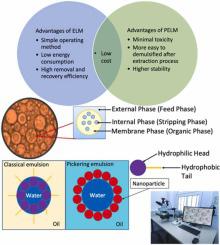当前位置:
X-MOL 学术
›
Chem. Eng. Res. Des.
›
论文详情
Our official English website, www.x-mol.net, welcomes your feedback! (Note: you will need to create a separate account there.)
Prediction of zinc extraction from aqueous solution using iron oxide nanoparticles embedded formulation for tuning emulsion liquid membrane stability
Chemical Engineering Research and Design ( IF 3.9 ) Pub Date : 2024-03-04 , DOI: 10.1016/j.cherd.2024.02.050 Norasikin Othman , Izzat Naim Shamsul Kahar , Soong Shen Long , Norul Fatiha Mohamed Noah , Shuhada A. Idrus-Saidi , Sazmin Sufi Suliman
Chemical Engineering Research and Design ( IF 3.9 ) Pub Date : 2024-03-04 , DOI: 10.1016/j.cherd.2024.02.050 Norasikin Othman , Izzat Naim Shamsul Kahar , Soong Shen Long , Norul Fatiha Mohamed Noah , Shuhada A. Idrus-Saidi , Sazmin Sufi Suliman

|
The contamination of industrial wastewater with heavy metals poses a threat to both aquatic and human life. In this study, emulsion liquid membrane (ELM) as a great potential process was applied to remove and recover zinc (Zn) from industrial wastewater. However, the instability of ELM continues to hinder their commercialization. Consequently, this research focuses on studying the stability of water-in-oil-in-water (W/O/W) emulsion in ELM with the aid of nanoparticles in the formulation. The emulsion stability measurement based on volume and pH were applied. Additionally, a digital microscope with a camera is utilized to assess emulsion stability in terms of globule size. ELM formulation with incorporation of iron (III) oxide (FeO) nanoparticles, and blended surfactant (Span 80 and Tween 80) were employed. The research investigates the optimal process parameters for W/O/W emulsion stability. This includes varying parameters such as nanoparticle concentration (0–0.08 % w/v), treat ratio (1:3 – 1:7), agitation speed (200–600 rpm), and time (1 – 5 min). The W/O/W emulsion with the highest stability was achieved at FeO concentration of 0.04 % (w/v), a treat ratio of 1:3, agitation speed, and time of 300 rpm and 3 min, respectively. Under these stable conditions, Zn extraction was predicted by simulation using a mathematical boundary breakage model of the process. The effects of the treat ratio, concentrations of synergist carrier (D2EHPA and Cyanex 302), stripping agent (acidic thiourea), and external feed phase were examined. The result showed that almost 100 % of Zn was extracted within 3 min at a 1:3 treat ratio, 0.03 M synergist carrier, and 1.37 M acidic thiourea for 50 ppm Zn concentration in the feed phase. This research highlights the tremendous potential of nanoparticle presence in enhancing emulsion stability and improving Zn extraction.
中文翻译:

使用氧化铁纳米粒子嵌入配方来预测水溶液中锌的提取,以调节乳液液膜稳定性
工业废水的重金属污染对水生生物和人类生命构成威胁。在本研究中,乳液液膜(ELM)作为一种极具潜力的工艺被应用于从工业废水中去除和回收锌(Zn)。然而,ELM 的不稳定性继续阻碍其商业化。因此,本研究的重点是借助配方中的纳米颗粒来研究 ELM 中水包油包水 (W/O/W) 乳液的稳定性。应用基于体积和pH值的乳液稳定性测量。此外,还利用带有摄像头的数码显微镜来评估乳液在球体尺寸方面的稳定性。采用掺有氧化铁 (III) (FeO) 纳米粒子和混合表面活性剂(Span 80 和 Tween 80)的 ELM 配方。该研究探讨了 W/O/W 乳液稳定性的最佳工艺参数。这包括不同的参数,例如纳米颗粒浓度 (0–0.08 % w/v)、处理比例 (1:3 – 1:7)、搅拌速度 (200–600 rpm) 和时间 (1 – 5 分钟)。当 FeO 浓度为 0.04%(w/v)、处理比为 1:3、搅拌速度和时间分别为 300 rpm 和 3 min 时,获得了具有最高稳定性的 W/O/W 乳液。在这些稳定的条件下,使用过程的数学边界破坏模型进行模拟来预测锌的提取。检查了处理比例、增效剂载体(D2EHPA 和 Cyanex 302)浓度、反萃剂(酸性硫脲)和外部进料相的影响。结果表明,在 1:3 处理比、0.03 M 增效剂载体和 1.37 M 酸性硫脲的情况下,进料相中 Zn 浓度为 50 ppm,在 3 分钟内几乎 100% 的 Zn 被萃取。这项研究强调了纳米颗粒在增强乳液稳定性和改善锌提取方面的巨大潜力。
更新日期:2024-03-04
中文翻译:

使用氧化铁纳米粒子嵌入配方来预测水溶液中锌的提取,以调节乳液液膜稳定性
工业废水的重金属污染对水生生物和人类生命构成威胁。在本研究中,乳液液膜(ELM)作为一种极具潜力的工艺被应用于从工业废水中去除和回收锌(Zn)。然而,ELM 的不稳定性继续阻碍其商业化。因此,本研究的重点是借助配方中的纳米颗粒来研究 ELM 中水包油包水 (W/O/W) 乳液的稳定性。应用基于体积和pH值的乳液稳定性测量。此外,还利用带有摄像头的数码显微镜来评估乳液在球体尺寸方面的稳定性。采用掺有氧化铁 (III) (FeO) 纳米粒子和混合表面活性剂(Span 80 和 Tween 80)的 ELM 配方。该研究探讨了 W/O/W 乳液稳定性的最佳工艺参数。这包括不同的参数,例如纳米颗粒浓度 (0–0.08 % w/v)、处理比例 (1:3 – 1:7)、搅拌速度 (200–600 rpm) 和时间 (1 – 5 分钟)。当 FeO 浓度为 0.04%(w/v)、处理比为 1:3、搅拌速度和时间分别为 300 rpm 和 3 min 时,获得了具有最高稳定性的 W/O/W 乳液。在这些稳定的条件下,使用过程的数学边界破坏模型进行模拟来预测锌的提取。检查了处理比例、增效剂载体(D2EHPA 和 Cyanex 302)浓度、反萃剂(酸性硫脲)和外部进料相的影响。结果表明,在 1:3 处理比、0.03 M 增效剂载体和 1.37 M 酸性硫脲的情况下,进料相中 Zn 浓度为 50 ppm,在 3 分钟内几乎 100% 的 Zn 被萃取。这项研究强调了纳米颗粒在增强乳液稳定性和改善锌提取方面的巨大潜力。



























 京公网安备 11010802027423号
京公网安备 11010802027423号